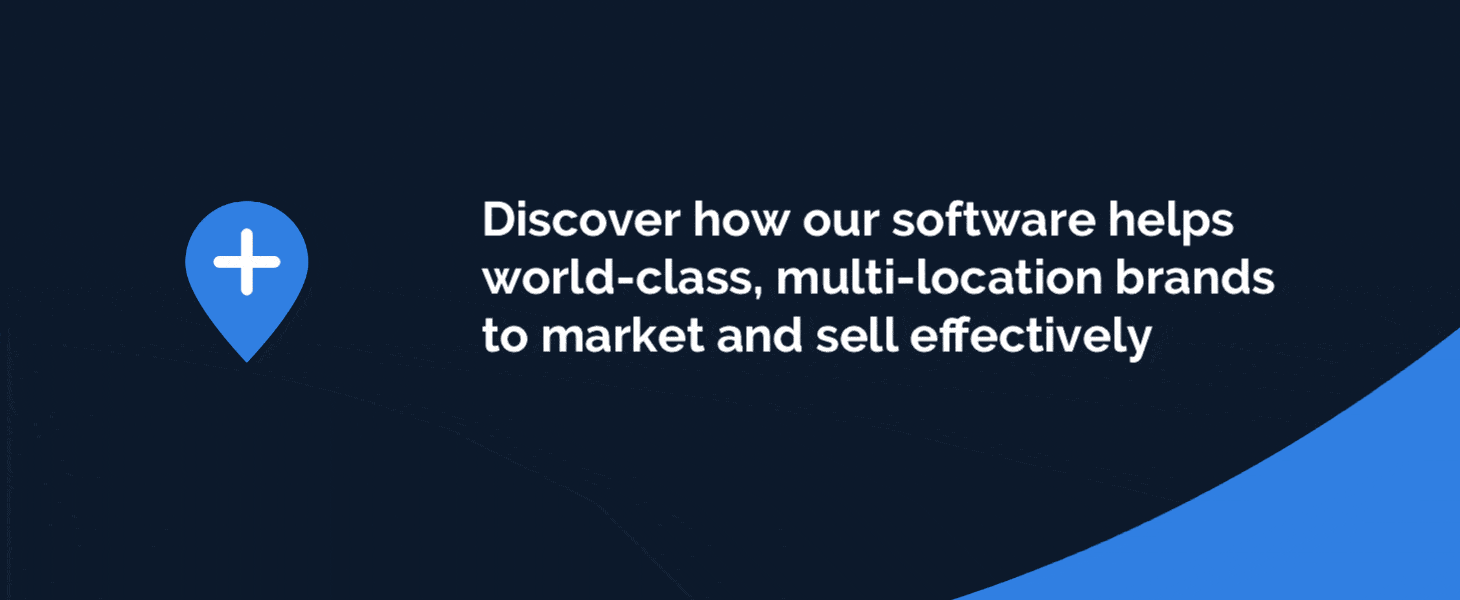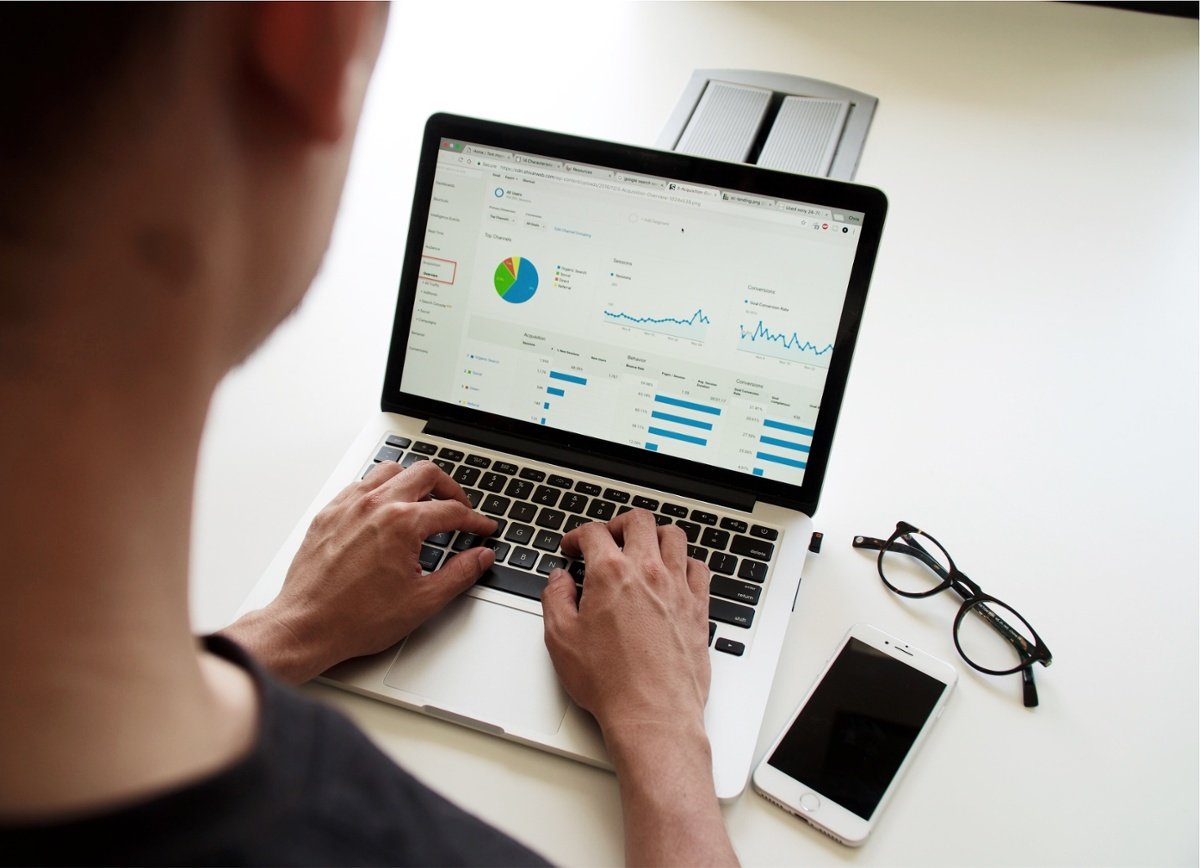CEOs and CFOs want more data from their brand marketing managers than just stats on social media engagement or brand awareness metrics. But measuring ROI for distributed marketing is notoriously difficult.
Across all types of businesses, 63% of modern marketers are unable to link their advertising to revenue in reporting, according to a Fournaise Group study. Distributed brand managers face the difficult challenge of having to collect results from a variety of different places (locations), and deliver them to a variety of stakeholders (CMO, marketing managers, agencies, etc). Meanwhile, local marketers may be focused on trying to determine the ROI of their local advertising to justify the cost of their annual franchise fees.
Technology and web analytics have made it much easier for many brands to measure the value of their campaigns and assets. However, accurate measurement is more complex for distributed organizations, who have to measure many different geographic locations and asset types that don’t include built-in analytics, like outdoor advertising.
Local marketing automation tools (LMA) can enable better measurement of results and marketer behaviors at specific locations. They also allow brand managers to unlock insights into how individual campaigns and assets are performing. If you’re facing pressure from all directions to produce revenue-driven reporting or justify the cost of investing in a new LMA tool, keep reading. We'll detail what ROI can look like for distributed brands, as well as some meaningful metrics you can adopt.
Fact: Distributed Marketing ROI is Notoriously Complex
ROI is likely the single, most common approach to calculating the profitability ratio, which is calculated as an increase in revenue compared to investment costs.
ROI Percentage = (Net Profit / Cost of Investment) x 100
When your CEO asks for the “ROI” of a marketing tool, they’re most likely asking for the percentage calculated using this equation. While ROI is an important metric, it’s not always an accurate tool for understanding complex types of change, like when a distributed brand management team implements software.
Why? Well, part of it is the metric's fault. ROI is NOT time-based. Unless your boss has asked for “the software’s ROI during Quarter 2,” it’s a measurement that’s not time-based. This is challenging in conversations about technology, which can yield increasing value over time.
More importantly, marketing isn't simple. Almost no marketing software project meets the criteria for a well-designed scientific experiment. Unless your organization makes no other changes to your processes, assets, or activities, you can't accurately attribute revenue to technology alone. This doesn’t mean it’s not a worthwhile measurement. It just means you might need to think about ROI for local marketing automation as a slightly more complex calculation than the basic equation suggests.
The 2 Ways Local Marketing Automation Drives ROI
At a high level, two distinct factors lead to ROI gains from LMA:
- Cost Savings
- Revenue Increases
Revenue increases aren’t an easy or tidy form of measurement for organizations who are producing a high volume of creative, which we delved into in the blog Return on Creative Investment: Fact or Phantom?.
Measuring revenue increases isn’t always easy because distributed marketing is a symphony of people, processes and tools. A really successful local marketing campaign after implementing LMA may have some revenue attributable to the software, but you’re also “borrowing” off of existing brand equity and the success of prior campaigns. It’s very difficult to tell the difference.
In addition, the revenue increases associated with local marketing automation may not be immediately apparent. As your local customers notice an increase in the volume, variety, and velocity of advertising at the local level, their brand perception may improve gradually over time and result in belated referrals or increased spend.
While revenue increases are a good component of overall ROI from LMA, brand managers should also be looking at cost savings. LMA software tends to improve efficiency, and thus reduces operating expenses. As you begin to look at ROI from your local marketing automation software, it's a good idea to start by calculating your cost savings and then graduate to measuring revenue impact.
Read on learn more about how local marketing automation software can drive measurable results.
22 Ways Local Marketing Software Drives Distributed Marketing ROI Across 4 Distinct Categories
Category # 1: Cost Savings and Risk Mitigation
If your organization has any existing cost or time utilization data in place, measures related to LMA-driven savings could be a “quick win” on your adoption journey. As soon as new creative workflows and processes are established, brand managers can begin telling ROI-driven stories to their executive sponsors.
1. Designer Time and Wages
LMA adoption may lead to highly-measurable decreases in how long it takes your design team to complete common tasks. Using an LMA with digital asset management tools for graphic designers could make template creation far more efficient, especially if your local marketing automation tool offers batch asset upload and metadata tagging features.
2. Local Marketer Costs
In many cases, brand managers have less oversight of how their local affiliates or franchises spend their time. However, it’s possible to communicate directly with your “super users,” or highly-successful early adopters of your tool, to get a sense of how the system has saved them time and effort. You can gather anecdotal evidence about the impact that user-friendly templates, integrations with social media, email sending, content management and other tools all have on their day-to-day execution of marketing programs.
3. Legal Fees
For organizations that are highly-regulated, legal review and guidance could be a significant cost center. Distributed marketing software can introduce greater efficiency in your legal review processes, by allowing brand managers to “lock” required disclosures at the local level and possibly even recycle messaging that’s been previously approved by counsel into new assets, automatically.
4. Agency Fees
Distributed marketing software helps brands working with agencies (as well as the agency) by eliminating the need for small tweaks and endless revisions to campaigns and marketing assets. This helps brands prioritize their agency resources. Less of your billable dollars need to be spent on revisions, which allows your agency to do what they excel at most: develop new ideas and create fresh campaigns for your brand. This can be enabled through faster time-to-discovery for existing assets assets, better asset reuse, and superior communications between brand teams, the agency and local marketers. For one web-focused marketing team, Adobe reports that DAM adoption spiked productivity 300%.
5. Storage Fees
For companies new to distributed marketing software, the right tool can eliminate the expense of having to pay for on-site or cloud-based storage for your digital assets, especially if you move to a nimble, SaaS-based LMA tool that includes cloud-based storage for all of your marketing collateral. Marketers should know that not all tools offer comprehensive, fully-scalable DAM databases like CampaignDrive, and some other solutions may require you to pay for, and integrate, a totally separate tool for storing assets.
Forbes’ Gina Longoria notes that SaaS tools in particular can drive several types of cost-savings, including less time and effort spent by your IT team (capital expense reductions), and switching from a customized legacy system that requires ongoing development spend to a SaaS solution with transparent pricing. It’s more challenging to measure indirect expenses of storage fees, such as the delays in campaigns when your former cloud vendor’s services went down, but it’s another driver of savings.
6. Legacy Software Costs
For many organizations, implementing an all-in-one local marketing tool can allow you to kick cumbersome, outdated software to the curb. You’re able to stop using that really disorganized FTP site with DAM features; pre-designed workflows may replace your customized project management tool; and built-in reporting dashboards could allow you to stop using tricky, third-party reporting tools.
For organizations with existing DAM technology, you may also never have to pay for licensing, storage or related fees again!
7. Regulatory Fines
Ideally, your organization has not faced any regulatory fines in recent quarters for failing to include required disclosures or meet compliance requirements for advertising. However, if you have, LMA can represent a solution to facing these costs in the future. Templates will ensure that local marketers leave all the required disclosures in place, without modifications. Brand managers gain better oversight of their local affiliates' activities, and even have the mechanisms to disallow certain ones.
8. Licensing Fines
DAM tools offer sensitivity to your intellectual property requirements, such as limited-time licensing agreements on third-party stock photography or audio tracks. If a digital asset is no longer available for use and distribution, a local marketing automation tool will automatically adjust asset permissions so a local marketer doesn’t accidentally add the photo to their Facebook page. Much like regulatory fines, organizations who have faced licensing fines in the past can use distributed marketing software to simply track the money saved.
9. Campaign Deployment Time
Not every brand manager has access to previous averages on campaign deployment. However, LMA enables you to access these insights through reporting tools at a regional, local or individual level. While faster campaign deployment doesn’t always translate to cost savings, this could be quantified at some organizations, especially if your brand management team is no longer performing time-consuming check-ins with local marketers about campaign deployment progress.
Category #2: Revenue and Value Growth
Revenue may be hard to quantify since local marketing automation never operates in isolation. However, revenue is not the only form of value your brand can measure or benefit from. By expanding your measurements to include a valuation of your digital assets and marketing intangibles, you can provide specific measurements on profitability and equity that are tied to activity in your LMA.
10. Increased Asset Creation
Distributed marketing tools like CampaignDrive make it easy for graphic designers to translate a single design layout into multiple assets. One email marketing template could be modified, adjusted, and reused to meet the requirements of many different campaigns or local marketer segments. Understanding how LMA impacts brand equity by helping create, store and provide access to more assets can be one way to measure increases in your marketing value.
11. Increased Online Conversions
LMA tools can help to centralize some of the many sources of online sales conversion that can make measurement tougher. If your brand is running a localized digital campaign through your LMA that gets tracked by your corporate landing pages and web analytics, you can gain direct insight into how LMA-supported campaigns are contributing to sales online. While attribution modeling isn't always an exact science, some part of this sales increase could then be attributed to the tool. And if you're able to measure conversion value, you can even give credit to your local marketing campaigns down the real dollars and cents they've helped to generate.
12. Increased Response Rates
If your national or local marketers have access to average response rates, measuring changes in response rates could also reveal some insight into the impact of local marketing automation software on direct mail, outdoor advertising, and digital marketing performance. While response rates can be affected by more than the software (the quality of the surrounding design or campaign messaging), local marketing automation software contributes to more compliant marketing at the local level, which in turn drives up response.
13. Customer Reach
For companies who place value on reach and brand awareness metrics, LMA could provide measurable value. The advertising reach of your local marketers could expand as they’re able to deploy a higher volume of assets, and adopt more channels for marketing through LMA integrations. In some cases, this can be quantified through local increases in foot traffic, direct mail distribution, and email marketing open and click rates.
14. Average Sale Value
Local marketers may rely on average sale value as a way to gauge the health of their business and the value they’re receiving from brand marketing support. Driving local satisfaction is often a goal of brand marketing teams, who may view the satisfaction of their franchisees or dealerships as a key performance indicator (KPI).
An increase in average sale value for local outlets could result from more than just distributed marketing software adoption. However, understanding how sales value for locals who engage most heavily with the software is trending compared with their less-engaged counterparts can reveal more specific insight. Asset-driven increases in category sales, such as a spike in customer demand for a specific motorcycle model following a direct mail campaign advertising that model of bike, could also speak to LMA’s value at the local level.
15. Repeat Purchases
Local marketing automation tools can support your local's ability to rapidly deploy a high volume of customer loyalty campaigns, including email “win back” campaigns or distribution of coupons to previous customers. LMA can also support your local outlets’ need to run loyalty programs efficiently. Your organization may be able to measure the specific increase in repeat purchases or loyalty program sign ups after LMA-adoption, and assign a broad revenue measurement based on the average value of repeat sales.
16. Upselling and Cross-Selling Revenue
The efficiency associated with LMA for both brand management teams and local marketers can introduce potential for new types of advertising, specifically targeted to upselling local customers. The revenue value of this could be quantified in both time saved on a per-asset basis and increases in cross-selling revenue that is aided by LMA.
Category #3: Visibility and Insights
17. Quality of Decisions
The local marketer’s ability to make smart marketing decisions quickly is an important indicator of how well your brand management team is doing at providing technology and assets that meet their needs. The quality of decisions metric, while not often discussed, is a useful heuristic in understanding how LMA improves performance. To establish the quality of decisions metric, assess the quality of decisions that your local marketers are making over time, in order to understand how your local marketing software is affecting their performance over time.
Bain research recommends identifying one or more area that has historically been difficult for your brand to gauge the quality of decisions within the company. If you're seeking to understand your local outlets' quality of decisions, in relation to their asset usage, look at the local marketer's usage rate of available campaign assets before LMA and after. Higher deployment rates, using more assets, could be one indicator of better quality of decisions. If your graphic designers are able to tag digital assets with the right campaign metadata consistently, LMA could be driving measurable improvement in their asset management decisions.
18. Asset Utilization
How your brands assets are being used, the frequency, and where local marketers are using them, is extremely important for distributed brands to understand. Brands spend hundreds of thousands of dollars a year on photoshoots, designs, and assets that can be used by local marketers. If you aren't tracking which assets are being used and how, you could be pouring funds into a channel that barely gets utilized.
Not every organization had great insight into local marketer asset utilization prior to local adoption. You may also struggle to quantify the “before” metrics on how effective your graphic designers were at using existing brand assets for new templates or campaigns. However, even if you create a baseline when LMA is implemented, asset utilization can be a long-term indicator of how effective your local marketing technology is.
19. Asset Performance
LMA tools allow brand marketers to easily see the performance of assets and campaigns among local customers, especially when it comes to digital and email content through web analytics, social media engagement, and more.
From a brand manager’s perspective, LMA reporting tools can help to gauge how often assets are being used, and if there is a correlation between channel revenue streams and specific assets.
20. User Behavior
For brand managers, highly-engaged local marketers are among the best indicators of a successful distributed marketing software implementation. Watching your locals engage with your technology can provide insight into the quality of your assets, the ease-of-use of your tools, and local stakeholder satisfaction. Measurements within this category of metrics could include:
- Frequency of logins
- Number of users/locations
- Time to deployment
- Number of asset types used
- Percentage total assets used
21. Campaign Status
Without technology, sending marketing materials to local marketers could leave you with very little insight into how brand assets are being used (or misused). Unless your organization had lots of direct communication with locals, it was often difficult to know exactly where your locals are in the process of customizing and deploying assets. Distributed marketing software allows you to understand the specifics of campaign status in terms of customization, deployment and even overall campaign performance.
22. Co-Op Spending
Local marketing automation software can make it much simpler for local marketers and brand teams to measure the status of co-op budgets and how they are being spent. This can be an invaluable measurement if locals frequently purchase key cards, customer loyalty cards, or other complex print items from third-party vendors. This metric can introduce transparency at multiple levels, including by making it easier for locals to understand the availability of their remaining marketing co-op dollars.
Who Says Distributed Marketers Can’t Prove Local Marketing Automation ROI?
“Show me the ROI” is a common request to brand managers who are trying to justify existing technology investments or make a business case for a new LMA tool. While it can be a relatively easy question to answer for an online store that only does digital advertising for a single website, it’s a lot harder for brand managers who are tracking revenue performance against thousands of locations, complex funding sources like annual franchise fees, and relying on traditional advertising in their marketing mix.
While proving the ROI of local marketing automation is hard, it’s not impossible. By understanding that the right technology investments can lead to money saved and money earned, brand managers can develop a picture of just how effective their software is. If you identify a set of 3-10 key performance indicators from the options above, you can tell a story about how your technology is supporting your marketing initiatives. These selected metrics could vary between organizations and industries, but they are likely to include some measures from each of the three categories listed above.
CampaignDrive by Pica9 is a local marketing automation software that helps distributed organizations scale and increase their bottom line. To learn more, speak with a member of our team.






